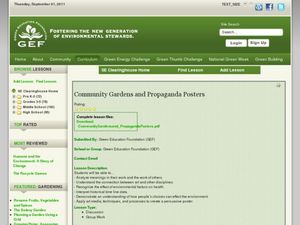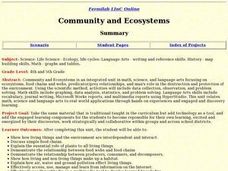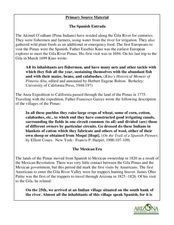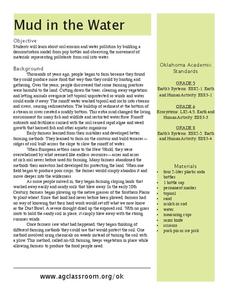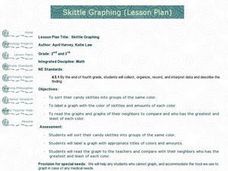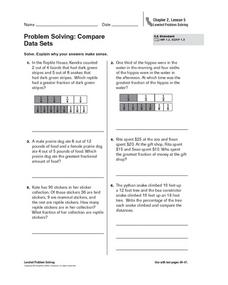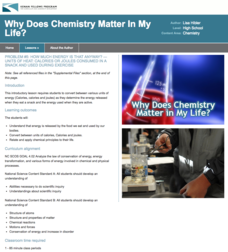Curated OER
Adding and Subtracting Algebraic Expressions (Combining Like Terms)
Everyone loves math when it includes food! This lesson tries to take the notion of combining like terms in algebra and comparing it to sorting apples and oranges. It takes a step-by-step approach to helping young scholars understand this...
Curated OER
Community Gardens and Propaganda Posters
Students research community gardens. In this community garden lesson, students discover the history of community gardens and assess the benefits of locally grown food. Students create propaganda posters aimed at inviting...
Curated OER
Mixing Colors
In this science activity, students drop food coloring into a glass of water. Students mix different colors to create new colors.
Curated OER
Water Lesson Plan
Young scholars discuss the importance of water in our daily lives. In this physics activity, students calculate the pressure of water tower systems. They investigate the effect of certain variables using a computer simulation.
Curated OER
Community and Ecosystems
Learners complete a unit of lessons on ecosystems. They participate in online activities, create a diorama, write journal entries, and develop a Hyperstudio multimedia project on a selected ecosystem.
Curated OER
Portrayals of Women in World War I
Students explore the contributions of women to the war effort. In this World War I lesson, students examine posters from the era that their instructor has gathered and analyze the message in each of the posters. Students then share their...
Curated OER
The Spanish Entrada
In this Arizona history worksheet, students read a 5 page selection that includes primary sources about time periods in the state's history. Students then respond to 5 short answer questions based on the selection.
Curated OER
Mud in the Water
Sixth graders investigate erosion. In this erosion lesson plan, 6th graders explore how farming changes the environment. Students construct an erosion model and research ways to protect the soil from excess mud generated by farming.
Curated OER
Skittle Graphing (Lesson Plan)
Students discuss the uses of graphs. They use color candies to count and sort before designing graphs. They label the graph papers with appropriate titles and candy colors. They complete the graph bars, and discuss the results with a...
Curated OER
Beowulf Lesson Plan
Learners analyze the text of Beowulf. In this epic poetry lesson, students explore the themes and imagery in the text to evaluate their meaning. Learners analyze the Old English language and examine the cultural and historical context of...
Curated OER
The Dinosaur Diner
Students explore the food chain. In this dinoaur lesson, students identify charactersitics of an omnivore, carnivore, and herbivore. Students sort dinosaur picture/word cards into groups by their eating characteristics. Students also...
Curated OER
Problem Solving: Compare Data Sets
There are a variety of techniques students can use to compare fractions. In this learning exercise on fractions, 5th graders are shown a way to create a visual comparison and asked to solve word problems. Students are encouraged to draw...
Curated OER
Math, Chemistry, and Food
Learners explore the effects of chemical reactions when cooking. Using the Internet, they research enzymes and then mix jello. They examine their results and test enzyme activity by adding pineapple to the jello. Finally, they test...
Curated OER
Food or Fuel?
High schoolers describe the process of transesterification utilizing chemical formulas. They construct and compare models of chemical structure of the substances involved in biodiesel production such as: alcohols, alkenes, alkanes,...
EngageNY
Experiments and the Role of Random Assignment
Time to experiment with mathematics! Learners study experimental design and how randomization applies. They emphasize the difference between random selection and random assignment and how both are important to the validation of the...
Serendip
Understanding and Predicting Changes in Population Size – Exponential and Logistic Population Growth Models vs. Complex Reality
Salmonella poisoning impacts over 200,000 people in the United States each year. Scholars learn about the growth of these bacteria using multiple approaches. Then they apply the same growth calculations to endangered species and think...
Population Connection
The Peopling of Our Planet
How many people live on the planet, anyway? The first resource in a six-part series covers the topic of the world population. Scholars work in groups to conduct research and make population posters after learning about the global...
Rochester Institue of Technology
Meal Picking
Scholars explore systems design and its relation to meal picking by using computer simulations to test systems designs. They learn about the Pick-to-Light System and calculate average picking times.
Cornell University
Sound Off!
Time to witness the effects of sound. Learners analyze different materials to determine their abilities to absorb sound waves. They use free software to monitor the amplitude of the waves to verify results.
Science 4 Inquiry
The Ups and Downs of Populations
As the reality of population decline across many species becomes real, pupils learn about the variables related to changes in populations. They complete a simulation of population changes and graph the results, then discuss limiting...
Indiana University
World Literature: “Wu Sung Fights the Tiger,” Anonymous - Commentary by Chin Sheng-t’an From Water Margin
Dive into classical Chinese literature with this packet. Provided first is a comprehensive summary and a half-page long historical context of Water Margin. As your class reads the section entitled "Wu Sung Fights the Tiger," pose the...
Kenan Fellows
How Much Energy Is That Anyway?
The fifth lesson in the six part series introduces units of energy including calories, Calories, and joules. Scholars determine the energy released when eating a snack and during activity.
Concordia College Archives
Introduction and Student Inquiry
Introduce young musicians to the history of and different styles of music with an inquiry-based learning activity that asks them to play detectives to determine the similarities and differences among the sheet music found at a series of...
PBS
Using Primary Sources: Wide Open Town
A picture speaks a thousand words, no matter how old! Scholars use political cartoons from the era of Prohibition and the Temperance Movement to analyze what, a primary document (in this case, a bootlegger's notebook) is telling them...
Other popular searches
- Cost/benefit Analysis Food
- Food Label Analysis
- Food Analysis
- Food Drive Data
- Cost Analysis Food Service
- Dog Food Analysis

